In 14 years, 1 in 4 children (25%) will have autism (graph below).
When I came across this graph recently, probably like you – I was alarmed… I’ve shown it to friends and family and the reaction of concern and disbelief has been the same.
The statistic is for rates in the USA, however rates in Australia aren’t slowing down.
Our children are our future. Why aren’t these statistics more commonly shared?
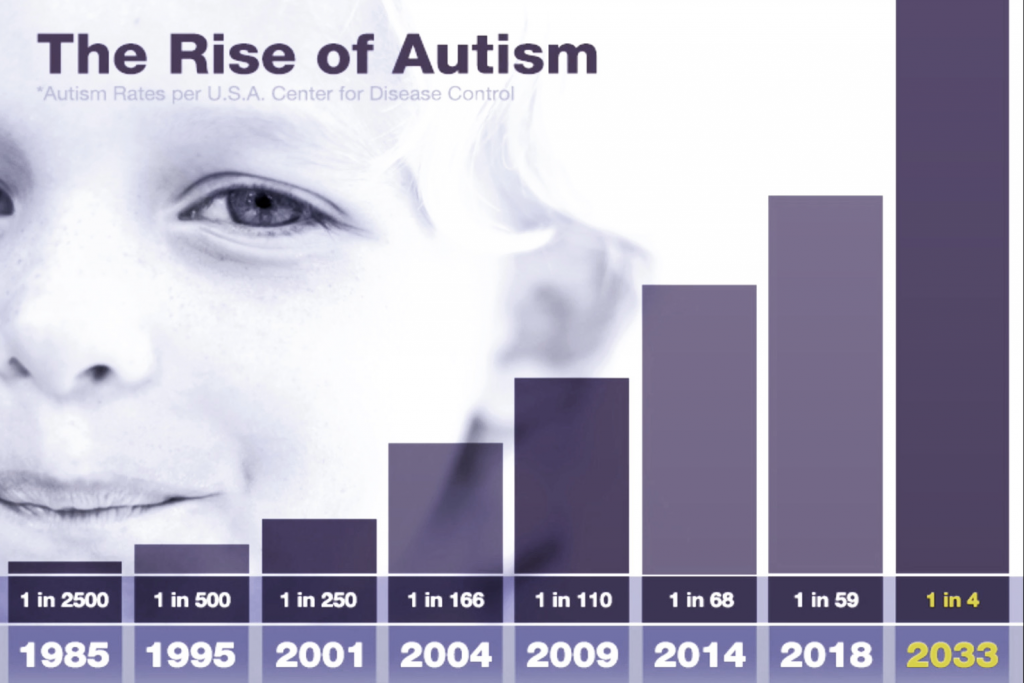
Image courtesy Mindd Foundation
I’ve worked for a number of years in the area of autism in a Board role. I understand the gifts these children bring into the world. At the same time they require care that other children do not. Autism not only impacts the child or person it impacts the whole family unit, especially primary carers.
The graph not only shows Autism escalating at an alarming rate, it shows;
It also means;
The impact on society at large will be devastating. As mentioned above, children and adults with neurological conditions such as autism often need more care and assistance, (they’re commonly dealing with other disabilities too). The impact on families is emotionally, financially and physically draining.
However it’s not just autism – ADHD & other neurological conditions are all on the rise.
‘Today, there are some 21 million children (almost 10% globally) who have been diagnosed with severe attention, behavioural, or learning problems… ADHD, autism spectrum disorder, dyslexia, tourette syndrome, obsessive compulsive disorder, bipolar, or other frightening conditions that confirm something is not right in the brain’ ~ Dr Robert Melillo, author of Disconnected Kids.
There’s more;
A 2019 report from the Australian Bureau of Statistics shows in Australia the percentage of children with 1 or more chronic conditions;
Why are our kids no longer naturally strong, vital & healthy as nature intended?
Some might say, it’s always been this way and now there’s better diagnosis or understanding of symptoms.
I don’t think so.
How many children did you know with neurological or chronic conditions when you were a child? Were there any? Fast forward to today and it’s likely you have a family member or a close friends’ child dealing with one or more of them.
It’s personal
It’s a story that’s close to my heart, as we too have done a lot of work with neurological conditions in our family. When I was told by experts and specialists ‘there was nothing we could do’, I trusted my intuition that there was something we could do and there was! We found answers. It’s taken a number of years with minimum intervention. If you know that feeling – trust it.
Hope.
Neuroplasticity gives hope for these neurological conditions.
For those who may not know this term, it’s the brains ability to change continuously through life…
In my personal experience & research neuroplasticity works, along with good food, detox, movement, sleep and other lifestyle ‘interventions’ can do a vast amount to nourish, detoxify, rewire and protect our childrens’ developing brains.
I understand autism is far more complicated and extremely challenging – I worked for a number of years with Autism West here in Perth. However there are many great stories of improvements and recovery being made e.g. Kirsty Wirth, founder at Kultured Wellness is an amazing example – read her story here and the Mindd Foundation shares recovery stories here
There are many wonderful functional doctors and practitioners doing amazing work in WA and across the world. These are a few I’m most familiar with in Western Australia;
Why is there an epidemic?
We don’t know why specifically, yet when I consider what’s changed in the past 100 years in the way we live there are some dramatic changes that all impact neurology (brain function).
Some thoughts;
Children’s’ developing brains are particularly susceptible to their environment, especially toxins. Toxins store in fatty tissue e.g. the brain, which is 60-70% fatty tissue. Any assaults that aren’t biologically compatible can impair brain development.
In our personal experience and as the stories of recovery show, it can take time, but the body returns to homeostasis (balance) and can thrive with the right tools and fuels unique for each individual person.
The younger children are when they get the support they need, the ‘simpler’ the recovery can be.
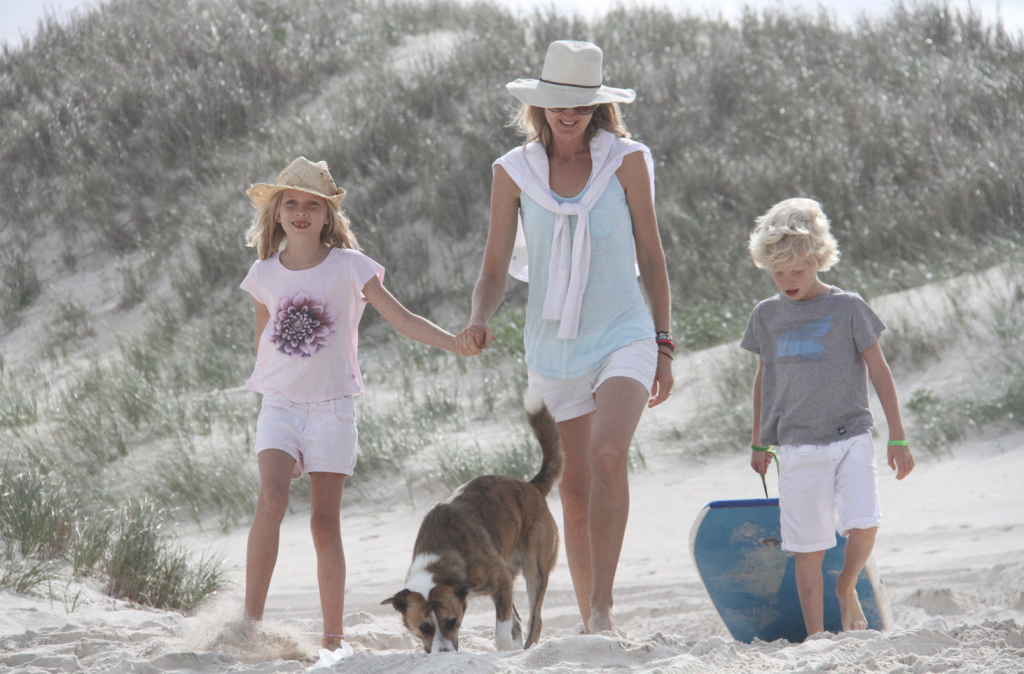
What next?
To be honest I’ve questioned if any type of intervention is necessary, for our family and for these kids? Is it their own path to learn from and offer their uniqueness to the world.
Often these children are gifted in other areas and do have so much to give – just as they are e.g. Greta Thunberg, the climate activist who has Asperger’s syndrome, OCD and selective mutism. Which in her words, ‘means I only speak when I think it’s necessary. Now is one of those moments.”
I think the answer is, if our kids are happy and are going to be happy, and as their parents, we are happy then THAT is what matters.
This aside, our children today are a long way from their evolutionary blueprint, and returning them to their most natural biological state has profound affects. There is much we can do as parents and carers to protect and nourish our childrens minds, brains and bodies, it starts at pre-conception, and as we now know, can be enhanced at any age.
Until we see these figures diminishing and we know we are on the right track, if you intuitively feel there’s something ‘not quite right’, I encourage you to act now e.g. to begin;
Complacency?
These illnesses and conditions are already common-place in children, but not common knowledge. Are we becoming complacent in accepting a new level of ‘normal’ for our children’s health that is not normal?
Here are my tried and tested, quick tips for maximising fun and minimising monster meltdowns at Halloween;
1. Celebrate.
2. Tricks. Help the kids with ideas for ‘tricks’, not just treats.
3. Trade. Before the big night begins, depending on the childrens’ age, chat about the affects of sugar & the additives & about ‘trading’ for something they love e.g. a sleepover, play date, out for dinner or a visit to the toy shop etc. (more expensive alternatives, but… better than a monster meltdown or worse, an immune system meltdown & days off school with sickness)!
4. Fill them up e.g. a big dinner before they go out & hopefully they won’t eat so many lollies?! Infact make dinner afternoon tea.
5. Water. After school and through the day fill them up with filtered water. It’ll fill them up & help their bodies process the sugar.
6. Investigate. For the older kids investigate (read) the ingredients / numbers. Download the ‘Chemical Maze’ app. Search the number(s) listed & then together read the symptoms & the effects specific chemicals have on their body – it works but it can be scary, so investigate yourself first, and before doing it with them – our kids are 12 & 14.
7. Enjoy the festivities. And the fantastic opportunity it creates to be outside, move their bodies, bring community and neighbours together. It’s a reason I enjoy Halloween, because it brings our street and neighbourhood together & the kids love it! #loveourstreet #loveourneighbours
And if the kids do go crazy you can support their immunity for a few days afterwards e.g.;
🍋 a vitamin c and zinc supplement.
🍋 early nights.
🍋 lots of nourishing, healing, real, whole foods. Eliminating sugary, processed and refined foods.
🍋 Add in a green smoothie or two.
🍋 essential oils if you use them.
And hopefully they won’t get sick, but if they do or if their behaviour is ‘off’, give them a loving reminder WHY.
Most of all have a fun night!
Sunscreen is not the answer to protecting our wellbeing that we’ve been led to believe.
For years we’ve been told we must use sunscreen and cover up to prevent lasting skin damage and cancer.
But have sunscreens been adequately tested for their safety and efficiency?
It’s something that’s been on my mind for a while (actually years) and perhaps for you too. And I’m not referring to ALL sunscreens, there are many with great ingredients that are more akin to skin food. If you’re using sunscreen they’re the ones to use.
I heard Dr Elizabeth Plourde, a licensed Clinical Laboratory Scientist share science that tells a compelling story with a different perspective. She’s researched the topic for many years and is the author of, ‘Sunscreens – biohazard – treat as hazardous waste’. references listed at the end of this post.
If sunscreens are potential ‘biohazards’ I’d like to know, and thought you might to.
In this post I share Dr Plourdes’ research and that of the Environmental Working Group (EWG) in the USA, along with proactive ways to protect our skin and elevate our well-being.
It’s my personal insight and experience and is not be considered medical advice.
Generally, it seems what we’re doing isn’t helping.
And then consider;
– Vitamin D is a hormone rather than a nutrient and is vital for strong immunity, healthy bones, anti-inflammatory, heart health, mood, weight management and much more.
– The majority of people across the world are vitamin D deficient.
With the above in mind, the sun is incredibly therapeutic, and quite possibly the ultimate in natures medicine. It is our friend and not to be feared or considered our foe.
Why sunscreens are harmful.
1. Concerning ingredients.
Hawaii has banned all sunscreens that contain oxybenzone and octinoxate due to the toxicity and devastating affect on the coral reef. A few sunscreens now promote themselves as being ‘reef friendly’.
Zinc dioxide and titanium dioxide.
The FDA (Food and Drug Administration) in the USA proposes there are 12 other active ingredients commonly found in sunscreens, including oxybenzone, that need additional data from safety and efficacy testing. These ingredients are used in more than 50 percent of the 1,300 + sunscreens EWG has assessed for their 2019 sunscreen guide.
2. Inferior protection.
When we first get in the sun, antioxidants protect the skin naturally, which is why we don’t burn immediately. When these antioxidants diminish we no longer have the protection and that’s when the skin starts to turn red, burn and we need to retreat to the shade. It’s our bodies inbuilt warning, signalling us to take protection.
When sunscreen is used it only blocks the 4% that is UV (ultra violet) B, that’s responsible for burning the skin. When these rays are blocked we are able to stay in the sun longer than we naturally would. When we stay out longer, that’s when the 47% of sun that is infrared i.e. UV A, can penetrate deeper into the skin and into the mitochondria (the energy powerhouses of cells) and cause cellular damage.
So in staying in the sun longer we don’t burn, but our bodies are exposed to potentially more damaging UV light, causing long-term cellular damage. Some sunscreens now block the UV A as well. But this may not be the complete answer…
Dr Plourde says tanning is an important mechanism. It’s the bodies’ way of protecting our cells from damage long term. It creates melanin, which naturally protects the skin and cells from being oxidized (oxidation is when molecules are ‘lost’ and lose energy, creating free radicals which then contribute to cellular damage). Meaning, we ideally need to tan and without burning.
My experience.
If you have fair skin, you might be thinking, ‘No way’, I just burn.
That was me too. I have fair skin and as a kid I burnt to a crisp and never really ‘tanned’! However, a few years ago I began to notice I tanned more easily and didn’t burn so easily! In fact people comment on my ‘tanned’ face. It’s taken time, but I sense my change in diet to a more whole foods diet and ‘cleaning up’ my home environment, and exposing my skin to the sun safely has helped improve my skins ability to metabolise melanin. I don’t know for sure and it’s hard to prove but it fits in with some of the research.
It’s important not to burn, and I’m not advocating that. However, if any of what I’m sharing resonates for you, trust your intuition.
Hormonal disruption.
If you’ve been doing the ‘right thing’, using sunscreen for many years, with the good intentions of protecting your skin, and slowing the aging process plus you’re doing great things with food and lifestyle, … but… you just can’t shift ‘stubborn weight’, or your hormones are imbalanced or blood sugars irregular or metabolism or have skin issues that won’t clear then perhaps there are ‘invisible’ endocrine (hormone) disruptors at play via sunscreen, beauty or personal hygiene products? Either way it’s worthwhile exploring.
Being sun smart.
1. Coverup.
Stay out of the sun during peak times of UV and infrared rays e.g. when it’s directly overhead.
Enjoy the sun in the early or later hours of the day. Monitor your skin to make sure it is not uncomfortable or turning red in the sun.
If you need to stay in the sun for long periods of time, use tight-weave clothing (hats, long-sleeve shirts, pants, etc.) to cover up when your skin has had enough sun.
2. Eat a bright rainbow.
A diet including more whole foods and foods that are rich in colour and antioxidants and give the body the protection it needs and access to the best source of vitamin D, the sun.
Antioxidant rich foods include;
3. Enjoy healthy fats. Fats like fish oils, animal fats also help nourish your skin, which supports a healthy production of melanin. Melanin is the pigment giving your skin its color or tone. These fats also reduce inflammation, helping melanin work more evenly and protecting the skin from damage. Personally, I just had to look at the sun as a kid & I burnt to a crisp! Now, after ‘upgrading’ my diet I rarely get sunburnt and am in the sun a lot. Learn more about healthy fats here.
4. As shared above, avoid toxic ingredients on your skin (and ingested into your body). Detox from any other toxic exposures and any you’re carrying. Redox cell signalling molecules are our no. 1 way for doing this gently & naturally.
5. Use a more natural sunscreen avoiding the chemicals and nano particles listed e.g. wotnot or soleo brands in Australia.
And if you or your family do happen to get a touch of the sun! My favourite remedies are redox cell signalling molecules, therapeutic grade lavender oil – incredible for alleviating burns and aloe vera gel, direct from the plant!
Summary
Anything we put on our skin has direct entry into the body and blood stream for circulation. It’s worthwhile auditing the products you’re using on your skin and your children’s skin, especially if it’s on a daily basis.
Every day we expose our bodies to a level of toxicity from our food and environment. If we aren’t consciously managing toxins, eventually they accumulate and will manifest dis-ease. Yet most of these exposures are easily managed. When we’re aware we can care.
Our skin needs exposure to the sunshine and for most of us it’s not getting enough. With Summer on the way it’s timely to check vitamin D levels and consider how much time your or your children’s’ skin sees the sun daily?
It’s recommended we use sunscreen everyday, even through winter. How can our skin ever do the job it’s so cleverly designed for, if it doesn’t see the sun?
When we cover our skin we prevent the metabolism of Vitamin D which in itself has been shown to be anti carcinogenic.
While sunscreens have a part to play in our sun protection, it’s likely there is more we can do to protect our skin from the inside out while honouring the vital and most natural relationship we have with the sun itself.
This is not medical advice it is my own personal insight based on my personal experience and science based research.
For more information on how to elevate your wellbeing, reduce toxins in your daily life and nourish your family with natures’ medicine, contact me, I’d love to hear from you.
Schedule your free 20 minute session here.
References include;
EWG 2019 Guide to Sunscreens https://www.ewg.org/sunscreen/report/executive-summary/
https://www.melanoma.org.au/understanding-melanoma/melanoma-facts-and-statistics/
Dr Eliabeth Plourde on Wise Traditions podcast https://www.westonaprice.org/podcast
Spring is my most favourite time of year yet… for 1 in 5 of us, this beautiful season is the absolute worst time of year.
Spring is when the pollen count goes up, which means for those 1 in 5 Aussies… a diminishing quality in life i.e. hay fever! Associated with non-stop runny noses, congestion, itchy, red eyes, constant sneezing, irritation in the ears, ear infections, sleepless nights, low energy and more…
It can feel unrelenting and what works for some, doesn’t always work for others, and symptoms can seem to suddenly develop later in life.
Each year, particularly in Australia, rates are incrementally increasing.
About 3.1 million Australians or 15% of the population had hay fever as a condition in 2007-08.
10 years later in 2017 – 18, nearly 1 in 5 Australians i.e. more than 4.6 million people or 20% suffer from hay fever. AIHW (Australian Institute of Heath and Welfare).
While Australia has one of the highest rates, in the UK experts report that by 2030 almost half the population i.e. an alarming rate of more than 30 million Brits will suffer from hay fever!
A good buddy got me thinking about this. She’s noticed that sometimes people respond to a treatment & then not the next time. Why? And why the escalation in rates? It got me thinking…
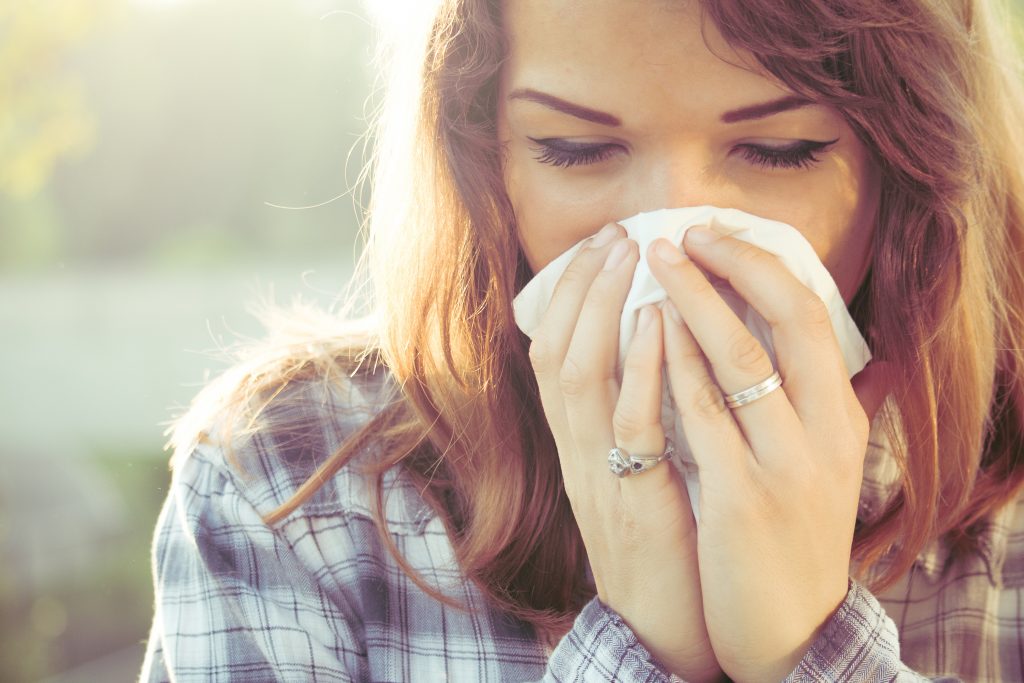
flu. young woman having a cold.
Some hay fever sufferers have NO family history or are developing it later in life. This, along with the escalation in rates seems to indicate the trigger is environmental rather than genetic.
To uncover what’s going on we need to look closer at the link between allergies and immunity.
Allergies and Immunity.
Allergic reactions begin in the immune system.
Take for example, a usually harmless substance such as dust, animal fur, fungal spores, mold, or pollen being exposed to a person with an allergy. This persons’ immune system over reacts and produces antibodies that “attack” the allergen (substance). This ‘attack’ triggers the symptoms.
Note, allergies are a different immune response to an autoimmune response. An autoimmune condition is when the immune system starts attacking the body’s own tissues, rather than an ‘over-reacting’ response.
Given 80 % of immunity lies in the gut, the state of the digestive system (gut) & the microbiome (bacterial population) must have a BIG part to play in the development of an allergy.
What creates the ‘state’ of the digestive system?
The state of the digestive system is primarily influenced by WHAT is consumed or what it is exposed to.
WHAT heals v WHAT harms?
The digestive and immune systems are incredibly complex, however very simply, it follows that consuming foods that agree with your biology or chemistry and exposing the gut to biologically recognisable substances, means the digestive system and therefore immune systems will function better and thereby lessen the chance of developing allergies.
What to do?
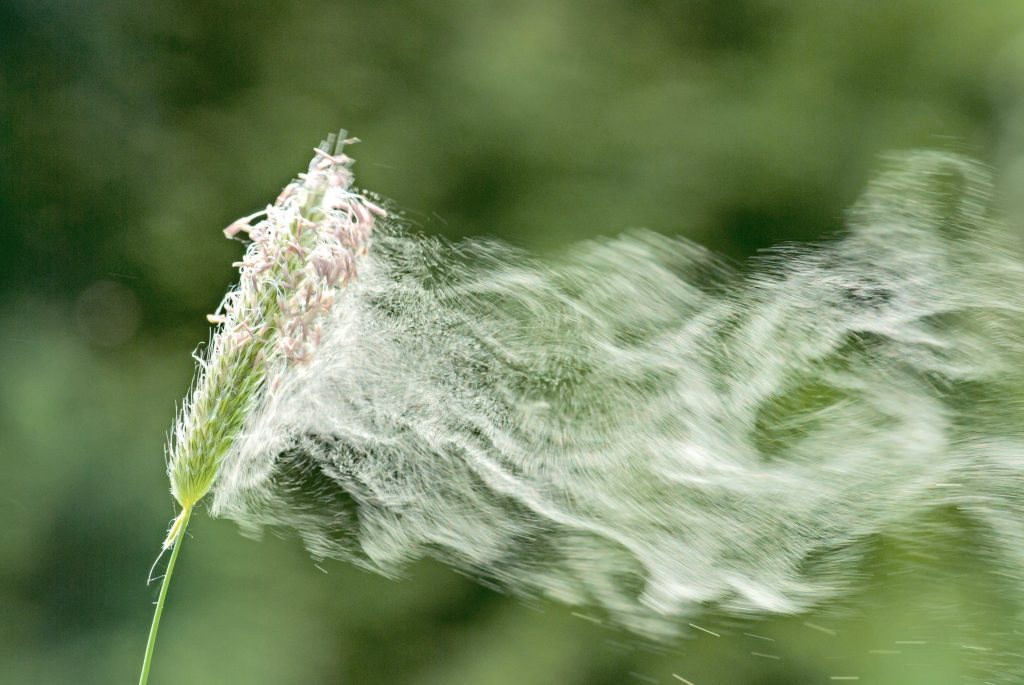
If you suffer from hay fever or allergies in general and haven’t already considered improving the health of the gut, start there, in particular the health of the microbiome.
And if you’re a hay fever sufferer consider restoring the microbiome of the nasal passages as well, (see below).
Remedies / Treatment
The 3 most common treatments for hay fever include; antihistamines, corticosteroids and decongestants. While they have their place and offer relief, they don’t offer a long-term solution.
In addition if the aim is to maintain the integrity of the microbiome (our bacterial population) and a healthy digestive system i.e. the seat of our immunity, then complementary remedies are worth exploring.
14 complementary remedies
These remedies can be quickly dismissed for their simplicity, but can be equally, if not more effective in their treatment.
Even though there’s not a quick fix, here are some ideas to relieve symptoms immediately and with time;
Let’s revisit the initial questions.
Given the thoughts in this post, perhaps it’s because the variables have changed e.g. this season the body is exposed to different pollens from the previous season OR
the individuals’ microbiome has changed since the previous season (the microbiome can change within days), or the diet has changed and the new foods have altered the digestive and microbial state. Or other changes in the environment.
Given that the health of the digestive system is paramount to a healthy immune system, the escalation in rates must have something to do with WHAT we are exposing our digestive systems to i.e. inferior foods rather than whole foods recognised by the body and unnatural / un-biological (inorganic) substances and toxins that disrupt the state of the micriobiome and digestive system, triggering dis-ease.
This is a personal reflection on how to give more long-term relief to so many people, and enjoy, what should be, a glorious and uplifting time of year. I hope it helps and gives ‘food for thought’.
And naturally, if symptoms persist, see your preferred health practitioner asap.
If you suffer from hay fever, I’d love to hear what’s worked for you?
Then if you’re keen to stop the cycle, let’s have a quick complimentary chat to explore your options.
Schedule your 15 minute session here.
References include;
https://www.ncbi.nlm.nih.gov/pmc/articles/PMC6056614/
https://www.aihw.gov.au AIHW (Australian Institute of Heath and Welfare).
‘The state of the nervous system is what dictates health or disease in any one body’ ~ Irene Lyon
With Springs arrival in Western Australia and the change of seasons, illness, coughs, colds and allergies escalate.
It’s got me curious….
If the nervous system dictates health or dis-ease in the body, WHY do people get sick with the change of seasons?
I’ve always thought it’s because there are a few more bugs around. But is there more to it?
Yes.
It seems the state of our brain (no matter the season) has a critical part to play.
Here’s why;
A Belgian study by Dr. Gilles Vandewalle, a neuroscientist, showed our brains respond to the changing seasons.
He cites, “Mood and immunity are well known to change with seasons in humans and there are indications that several brain aspects could also be seasonal.”
So perhaps the ‘seasonal change’ in our brains is what affects our mood and immunity with the change of seasons or vice versa?
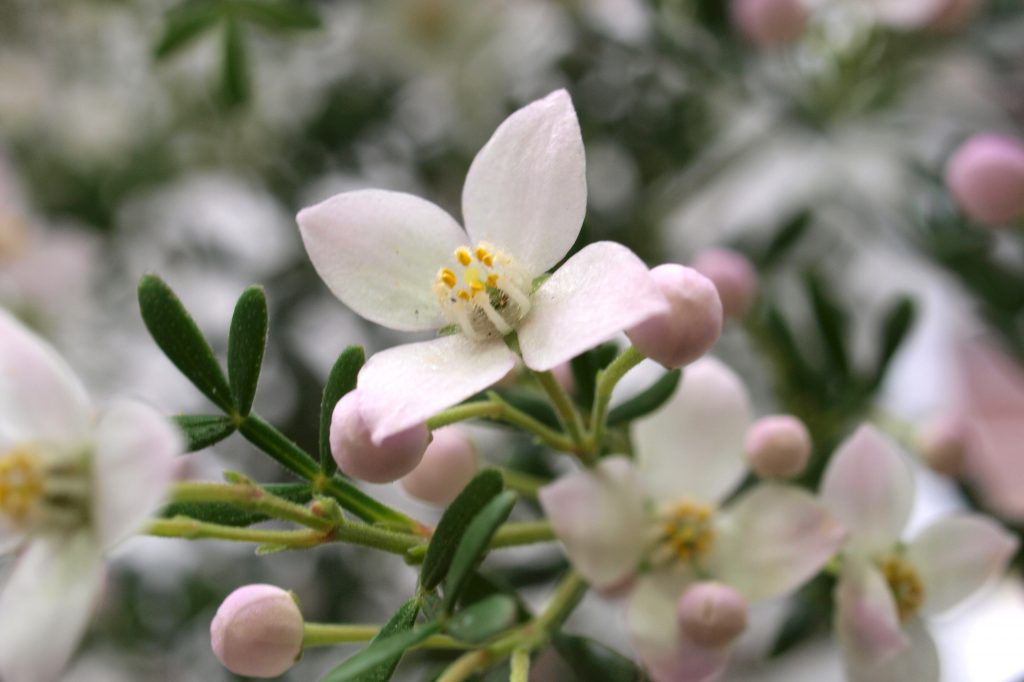
Spring Boronia
And why SAD, Seasonal Affective Disorder, is experienced through the winter months. SAD is a condition associated with feelings of hopelessness, low energy, changes in sleep or eating patterns.
Or why there is evidence that shows a higher incidence of suicide in late spring / early summer. In fact Australias’ national day of action, R U OK day to support people struggling with lifes’ ups and downs, was this week, September 12th. There are many, many significant factors associated with suicide, yet the seasons / weather also seems to be influential.
It’s a timely reminder to take even more time to be with those you are close to and who are a little more vulnerable at this transitional time of year and check in with how they are going? Really?
How the brain governs our body.
There’s an intimate connection between our brain and our body and this connection affects far more than our mood and immunity. It can affect inflammation, the endocrine (hormonal) system, circulation (the heart) and even metabolism!
Via this connection the brain fundamentally governs our body.
The connection being….
The vagus!
If you haven’t heard of it, keep reading, it might just reset your entire well-being & it’s FUN.
Viva Las Vagus!
The vagus is the longest nerve in the body, connecting the brain with the Gut, heart, liver, pancreas, gallbladder, kidney, lungs, mouth and more…
Vagus means wanderer in Latin, which is how the Vagus works, wandering around the body through the organs.
The vagus sends information about the state of our organs back and forth to the brain. Therefore if the vagus system isn’t functioning well or ‘toned’ – this important communication network malfunctions, potentially affecting every organ and system within us.
For example, this connection helps regulate;
Tone your vagus. Regulate your stress.
Let’s get sciency for a moment.
The vagus is the main component of your parasympathetic nervous system i.e. your rest and digest response – which is also where the healing state is most likely to occur.
Without going into too much technical detail, the tone (‘health’) of the vagus nerve regulates your tolerance to stress (fight and flight response)! With 60 – 80% of Doctors visits being stress related and most illness directly relating to stress, the tone of your vagus nerve, has a key role in protecting you from dis-ease.
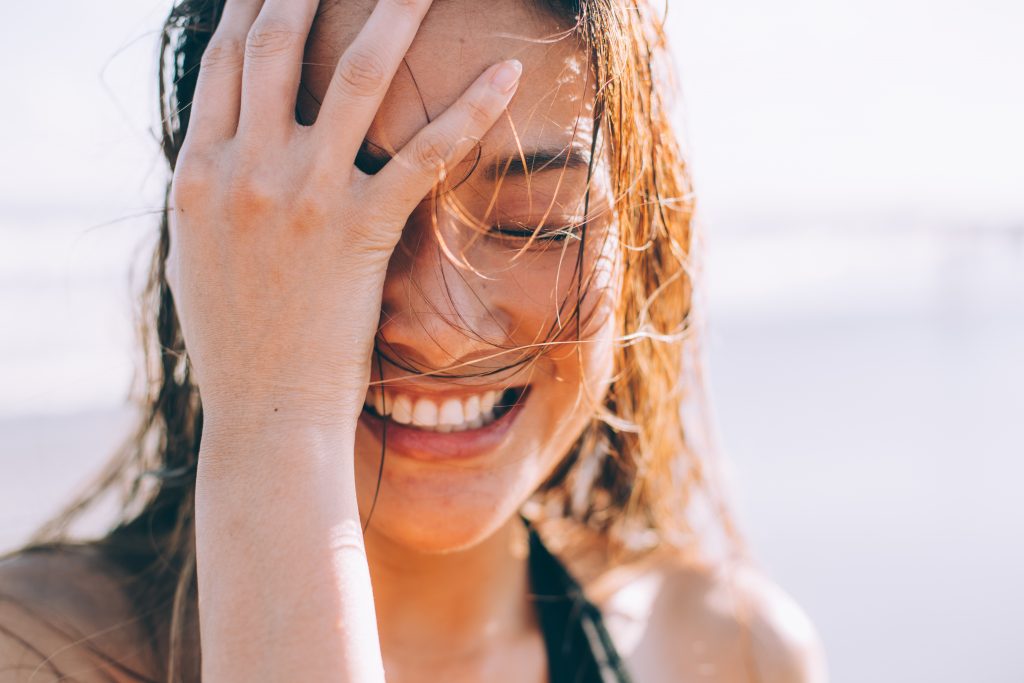
5 examples of this intimate connection at play;
https://www.psychologytoday.com/au/blog/the-athletes-way/201607/vagus-nerve-stimulation-dramatically-reduces-inflammation
And if you’ve lost connection to your gut instinct (your intuition) or not sure what I’m on about, then perhaps that’s another reason your vagus needs a little more toning too.
If you suffer from an inflammatory condition, digestive upset, blood pressure issues or mood disorders, perhaps it’s time to take a closer look at your vagal tone?
11 simple ways to tone your vagus.
1. Deep, diaphragmatic breathing with a long exhale.
Breathing deep instantly initiates the ‘rest and digest’ response i.e. the parashympathetic nervous system and the vagus – which is thereby in charge of turning off the ‘fight or flight’ reflex.”!
In doing this it can simultaneously work to reduce heart rate and blood pressure – all by taking a few deep breathes!
Other quick and easy ways to tone the vagus;
So many simple and FUN ways to keep your being well!
Which one or two can you start to add in?

Perhaps adopt the latest craze of ice bathing! You don’t have to fly to Alaska, a cold shower or a dip in a cold ocean in winter does the trick…
Summary
Our bodies are complex and none more so than the physiology of our brains, the conductor. Therein – intimately connected to every organ, every system and ultimately every thing. To then treat the body within it’s unique parts, rather than as a whole, is to simply place a bandaid on the symptom, rather than exploring the root cause for ultimate healing – which is likely to lead to the brain & the gut.
The vagus nerve plays a vital role in the process & the gut/brain axis, maintaining homeostasis (balance) in the body including; inflammation, digestion, the regulation of food intake, satiety, stress tolerance and energy.
Hence why seasonal changes, which can initiate changes in the brain / nervous system have a direct impact on our vital bodily functions, such as our immunity, mood, digestion and so much more.
So now you’ve got a few more great reasons to relax your nervous system, tone your vagus and stress less…
Viva Las Vagus!
References;
https://www.ncbi.nlm.nih.gov/pmc/articles/PMC5859128/
https://www.huffingtonpost.com.au/entry/brain-activity-seasons-study_
https://www.ncbi.nlm.nih.gov/pmc/articles/PMC3315262/
https://www.pnas.org/content/early/2016/02/04/1518129113
https://blog.daveasprey.com/vagus-nerve-vagal-response/
‘Cooking with love provides food for the soul’
It’s no coincidence the word art forms the word Heart.
Art: the expression of creativity and imagination… It’s about producing works to be appreciated for their beauty or emotional power.
Heart symbolises Love. It is known as the seat of emotions, the heart is synonymous with affection. And art has the power to ignite these heartfelt emotions.
Heart, love and food.
… The preparation of home made food then is artistic. When we are creating recipes from beautiful raw ingredients, creating delicious, appetising food, nourishing loved ones, we evoke feelings (emotions) of warmth, happiness and love. When we feel deeply, we create life long memories that we can revisit in an instant, evoking those same loving memories. It touches our heart.
So, when I saw an article in the West Australian, ‘Children just 8 and on diet apps’ it saddened me and fired me up…
Firstly. There’s something about Lamb Chops!
My most favourite foodie memory is returning home to our family farm from boarding school. We’d often get home around 6 – 7pm, just in time for dinner and be hopeful or having put in our order, for Mums home made, crumbed lamb chops! For all 3 of us kids it was our favourite family meal. A recipe handed down from my Grandmother to my mum. Lamb chops made everything feel right again. We’d eat it together, sharing our stories of school, what had been happening on the farm, the world and catching up after spending time away from each other.
And I fondly remember after travelling overseas for a year, it was the first home cooked meal that mum made for me. I felt happy. I felt loved. I felt home.
But food does that doesn’t it?!
Food has the power to bring us together. It’s the vehicle for sparking engaging (emotive) conversation, appreciation and love for the time and energy spent preparing and creating it. Reward in giving and receiving equally. It evokes feelings and life long memories. And although Mums crumbed lamb chops may not have been especially ‘beautiful’ they certainly had emotional power i.e. it touched my he(art).
There’s an app for that…
Which brings me to the new weight loss app for children aged eight to seventeen. An app that’s been developed in the USA to help kids manage their weight. ‘Designed to be simple, fun and effective’. The app encourages kids to track their own weight and food intake and monitor their diet based on a traffic light system’
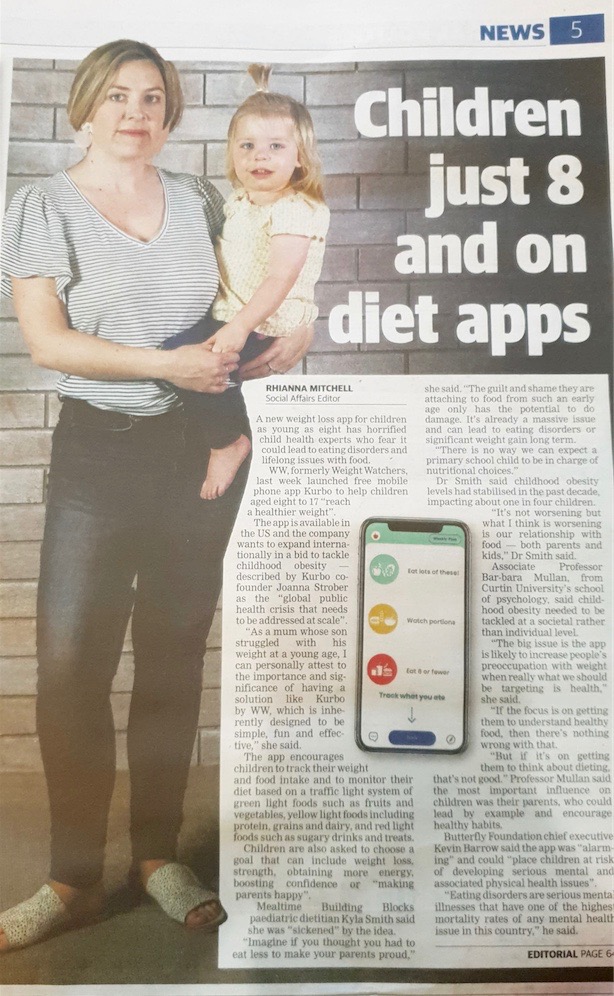
Argh. I cannot believe our most natural relationship with food has come to this? Children learning what food they need to eat from an app. It’s not right and it’s not healthy.
For me, it’s another commercial bandaid, designed with good intention (?) that’s covering up two deeper dysfunctional, societal issues at play.
First up.
When we eat foods in their most whole and real form i.e. unprocessed and unrefined, there is no app needed. Children have a much greater chance of maintaining their weight, easily, naturally, with no overthinking or digital device required.
However there is a trick.
Eating whole foods requires some preparation time, energy, a touch of creativity and hopefully a healthy dose of love. In eating food this way, the benefits are 100x worth it.
The simple act of preparing food at home with our families is one of the most important acts we can perform, (even if you think you can’t cook, give it go, it’s so worth it).
In our homes, while preparing and creating food, we powerfully create;
Looking at an app on a device, getting takeaway or store-bought meals, creates missed opportunities and a void for the most fundamental of these human needs to be met.
The app is a bandaid. There may be a place for it, but not before exploring if it’s in-fact covering up these two deeper issues.
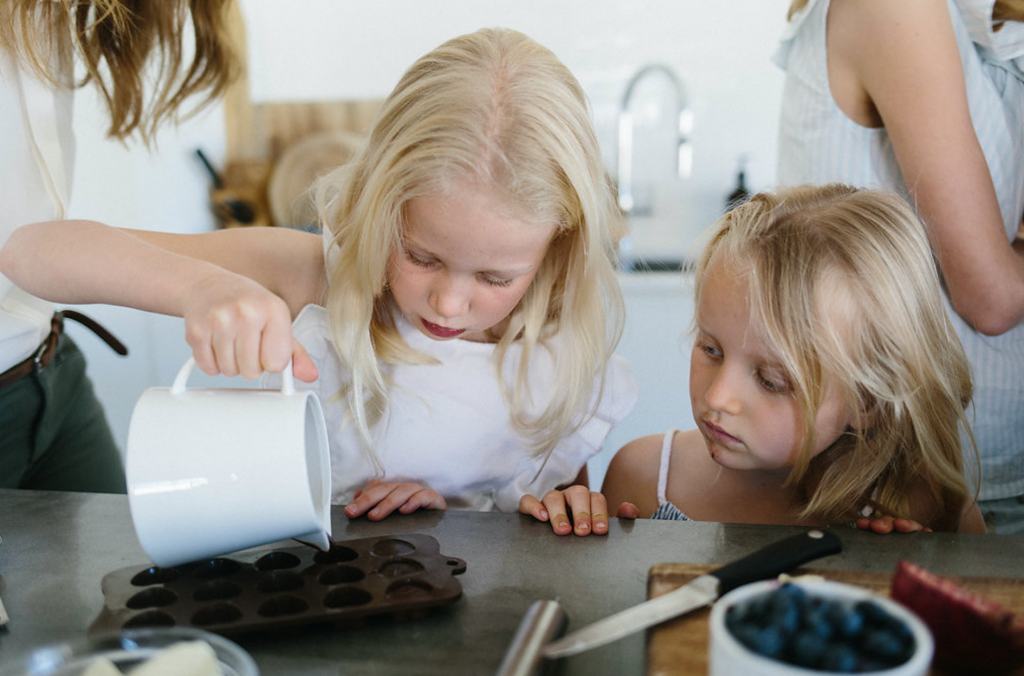
Re-discovering the he(art) of food and our childrens’ health.
1. Outsourcing responsibility.
Parenting is busy and at the same time, it’s become very easy and the norm, to outsource food preparation, meaning we no longer need to prioritise time for the simple and most important art of creating home made food with our families, sharing, explaining, learning about the food and eating, enjoying it together.
Rather we are outsourcing it for the convenience of packaged food, takeaway or… an app.
Life is busy and it’s an easy choice to grab something ready to go and every now and again, that’s totally fine, but when you do, take a moment to eat it together, mindfully and gratefully.
Preparing and creating a meal at home IS the most simple, fundamental and important act there can be as a Parent.
2. Convenience.
The convenience of modern day living is inconveniencing and affecting the health of our families.
Take a moment next time you’re tempted to make a time efficient choice and decide if you really need to outsource that action or say ‘yes’ to that activity or event or if it’s actually better and potentially more enjoyable, to say ‘no’ or ‘I’m going to do it myself, together’?
When we’re too busy to properly cook, it’s easy to be drawn into societal norms without thinking twice, and actually when we take time to think it through the easy way out is usually not in the best interest of your or your families well-being.
Restoring our relationship with food, a culinary adventure.
In our recent visit to France, we experienced a culinary adventure with the beautiful and charismatic Mimi Thorisson and her family. Mimi has created a lifestyle business, one that seamlessly combines her life, business and family. I think living life this way makes life easier and something I aspire to.
Generally, French people are amongst the healthiest in the world, and their children have the lowest incidence of obesity in the world.
I learnt why.
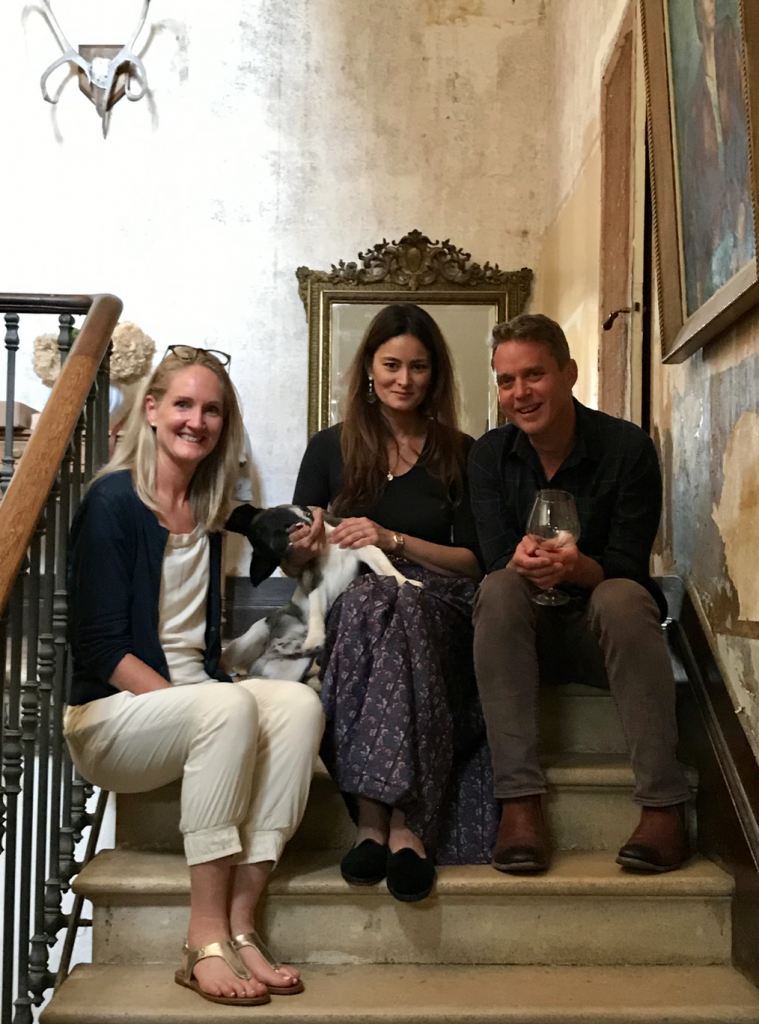
Food isn’t convenient, it’s at the heart of their lives, especially for Mimi. While we were there, we didn’t see any advertising promoting fast food, (actually very little advertising in general).
Here’s what I learnt about Mimi’s philosophy / relationship with food, and I love;
It was an incredible experience, sparked by a common love of good food, shared with strangers who quickly became wonderful friends with life long memories made. (And if you haven’t discovered Mimi yet, you can find her on instagram and enjoy her many cook books).
The simplicity of good food and what it has the power to create, really is magic.
But… I know as Mothers this might sounds like a fantasy! We can quickly lose the energy for preparing and cooking home made food, especially if children are turning up their noses up at it! I know how it is. I definitely have days like this too. So keep reading… I have something that will help.
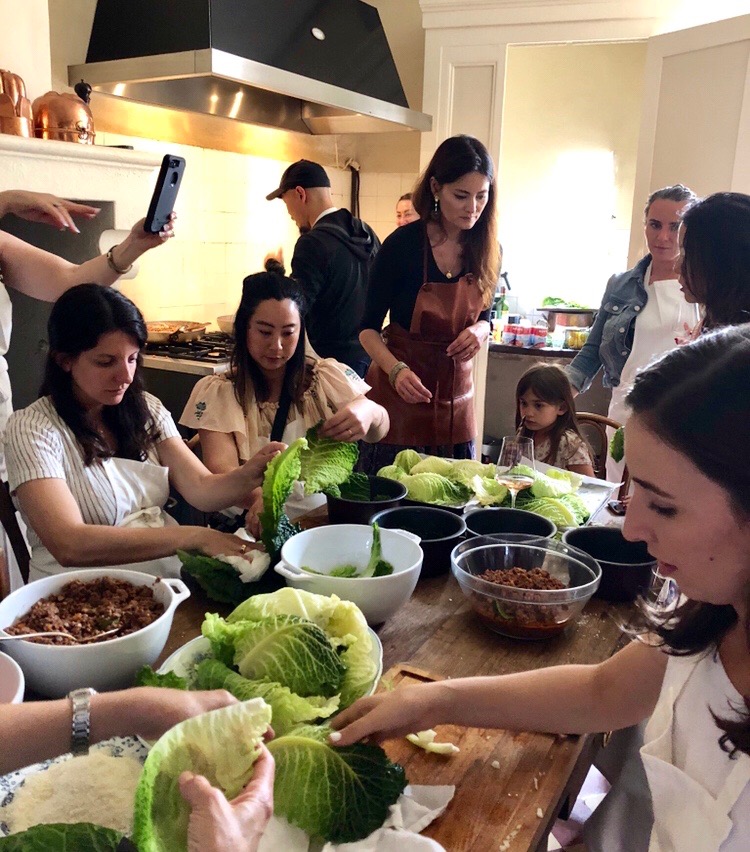

The Summer Abundance Workshop with Mimi.
In Summary
Childhood obesity is one of the most serious global public health challenges of the 21st century, affecting every country in the world. And it needs to be addressed there is no question but unfortunately an app or food monitoring is not the solution. Rather it’s another (in)convenient, quick fix that doesn’t get to the deeper issues at play.
Kids don’t need more reasons to be on their devices, especially as an 8 year old. There is much more to managing childrens’ weight than monitoring the food they’re eating.
Briefly, holding weight, for any of us, also relates to;
If these issues aren’t addressed as well, then no matter what we eat, or what app we use, we won’t release unnecessary weight.
We are emotional (feeling) beings.
Emotional wellbeing is equally if not more important than the food we eat, yet food has a pivotal role in creating the space that brings us together which helps in regulating emotional wellbeing.
Our children (and we) need, connection, engagement and stimulation of their senses. As their parents we are the primary creators of experiences to expose them to these experiences and the preparation of food is a simple, everyday act that is the perfect way to create this.
The power, connection and emotion that comes from preparing a simple meal together from beautiful raw ingredients and then what that creates when it’s taken to the table, everyone gathers and sits down to enjoy it and eat it together. There is magic in the memories made, the pride taken, the love shown in those moments. It can not be understated. Just like a simple meal of crumbed lamb chops.
Let’s reconnect with the joy and the memories that preparing and creating food creates. If we are preparing and creating food at our tables, we don’t need apps or digital devices and kids will never have to worry about ‘watching their weight’ and have the time and ‘head space’ they NEED in todays world, for fulfilling their most basic, intrinsic needs for health and happiness.
The positive relationship with food our children need can only be fostered by us, their parents or their primary caregivers. There is nobody else and ultimately, I don’t think any of us want it any other way.
What is your relationship with food and how is that affecting your childrens relationship with food? I’d love to hear your thoughts.
Let’s GLOW!
If you are lacking the energy, motivation or inspiration to create these magical foodie memories and moments in your home or the whole idea seems like a fantasy… I understand. I’ve been there too, and it can feel hard. I know when I’m feeling good, I’m happier and I’m more interested in cooking for my family and to be honest, engaged with my family. Sometimes we need a healthy kickstart…
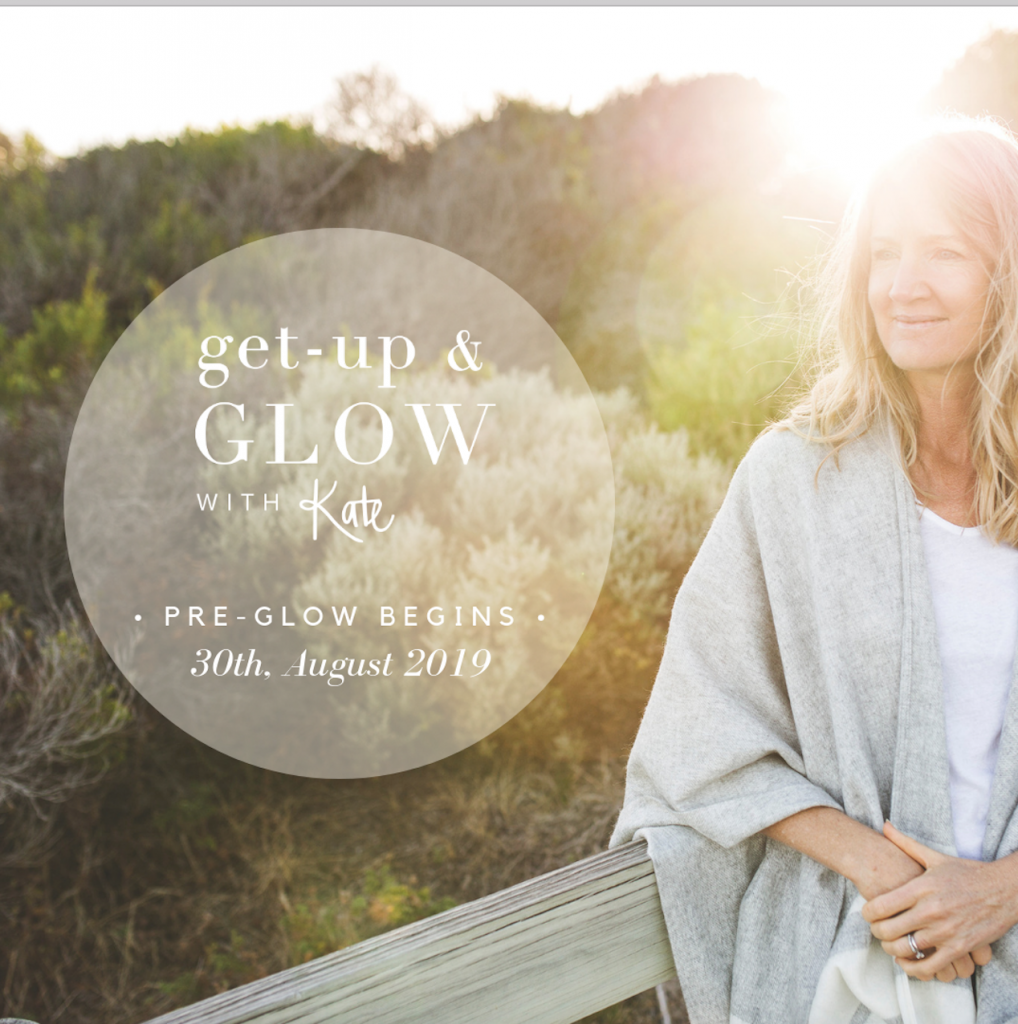
If you can relate to this, a healthy kickstart is just what you need for you and your family. It’s time to Get Up & GLOW!
GLOW is my 21 day vitality reset protocol, nourishing for mind, body and soul to get you back to your radiant self, glowing from the inside out.
It is the ultimate healthy kickstart. Do it for you or do it for your family. We start next Friday 30th of August. I hope you can join me. Register here.
And in the meantime enjoy making your foodie memories.
In brief here’s how our posture fundamentally affects our vitality and wellbeing;
1. Our energy increases. With better posture, muscles function better and therefore the nervous system and vice versa operates better, hence improving our overall energy. For example, you may have noticed in some children with poor muscle tone, that they can tire quicker than other children.
2. Stress reduces. With the nervous system functioning better, stress is better tolerated and mood improves. When the body is slumped/crouched, it’s also a position that ancestrally protects the vital organs. This response then also signals to the (ancestral) brain there’s a potential danger and heightens the bodies stress response.
3. Wellbeing improves. If the body is better aligned i.e. posture improved, the body is automatically more open. Therefore digestion, respiration, circulation etc all function better. For example, try this quick exercise. Consciously move to a slumped position and try deep breathing or eating your food?… It’s not easy or comfortable, is it? Posture affects how well we digest and absorb food plus the ability to breathe well i.e. deeply. With a shallow breathe i.e. from the chest this action also initiates the bodies sympathetic nervous system i.e. fight and flight/stress.
Interestingly, another indicator for longevity is glute strength! Those areas in the world known for longevity, the blue zones, also show that elders squat regularly in their day and have strong glute muscles. The gluteus (glutes) are comprised of 3 muscles. They are one of the largest muscle groups in the body. If they’re strong and used often, they’re going to affect our natural energy as well as our posture.
4. Injury prevention (& pain management). When the body is aligned and moving well, then we are far less likely to endure injury or pain. This is a big motivator for me in improving my posture and bodies alignment. I want to be able to keep running. I found This TED talk by Annette Verpillot, founder of Posture pro fascinating.
Poor posture.
Commonly we think poor posture is a result of not being conscious of how we’re carrying our body or laziness.
It’s actually more likely to be a result of poor muscle strength, particularly core or glute strength which can relate back to the feet, the nervous system and therefore how well the body is communicating to the brain & vice versa.
Why we need happy feet.
Our feet are some of the most nerve-rich parts of our body, directly communicating to our brain.
The brain relies on sensory receptors in our feet & other areas to gather info. To achieve this our feet need to touch their environment ie ideally barefoot.
Yet our often neglected feet, spend most of the time packaged up in shoes & not getting the sensory touch they (our brain) needs…
The foot not only helps us move but it’s also used by the brain to make subtle adjustments in our gait to protect bones and joints all the way up the body and to maximize the efficiency of how we move.
It makes sense then that how well we move actually depends on how well our feet (& ankles) move. And of course, for our childrens’ developing brains, barefoot or soft soled shoes are even more important.
What I’ve noticed.
Personally, I’ve found that the weakness in my left leg etc. originates back to childhood, when I broke a big toe and learnt to walk on the left side of my foot rather than the ball of the foot which has affected my whole left side (as different muscles were used for daily movement). The left side of the body is the side of our feminine energy and influences the right/creative side of the brain.
I don’t know for sure, but from all that I’m learning is it’s a likely explanation and has repercussions for emotional wellbeing and much more.
And naturally, if the body isn’t aligned, then ultimately it can predispose us for dis-ease.
So here’s what I’m loving and is helping me strengthen my feet, toes, glutes and overall muscular/nervous system and ultimately brain health (I hope).
The moves I’m making.
I’d like to say meditation but I’m yet to get a regular practice happening! It’s all work in progress, and I haven’t jumped to all of the above at once, no way… it’s been a natural progression and now I use different modalities depending on what my body needs. So if you’re interested don’t feel you need to do it all at once, do what feels right, one nourishing ‘step’ at a time.
Keeping moving.
In the research I’ve been doing and the changes I’ve been making in my own movement / posture practices, I’ve begun to understand that movement is MORE important than the food we’re eating! The affect is so significant on the nervous system that it means we digest and absorb our food so much better.
Now take a moment to consider where there might be a ‘kink’ or two in your (& your childrens) incredibly intelligent body that could benefit from a little more love and attention?
If this information resonates for you then begin with one small change at a time e.g. being barefoot more often or giving your feet a bit more movement rather than being packaged up in shoes all day or working at the coffee table or having picnics on the floor with the kids. Whatever it might be, keep it simple and keep it fun.
And I’d love to hear your thoughts in the comments below.
My hubby and I are going on holiday for a couple of weeks & leaving the kids! (first time)!
I don’t want them (or us) getting sick in the leadup or while we’re away! And I’ve had lots of people asking me about ways to avoid the flu shot & boost immunity, so I hope this post helps you & your gang too (btw all these tips & lots more are in my ebook, ‘Why kids get sick’)!
Here’s what I’m amping up;
1. Foods …
🍃 A good breakfast, helps stabilise blood sugars as well as start the day with a whole lot of nutrients.
🍃 A green smoothie each day with lemon, ginger,herbs & a touch of garlic. (Add a sweetener eg fruit or coconut water & they won’t know)
🍃 Plant variety to feed a diverse microbiome (good bugs) e.g. in salads / steamed vegetables and ‘snuck’ into meals e.g. mince, smoothies, sauces etc. & in smoothies.
🍃 Herbs and spices into cooking e.g. ginger, turmeric, garlic, cumin, coriander, cinnamon, fennel etc.
🍃 Organic berries.
🍃 Slow cooked meat on the bone for additional minerals.
🍃Healthy fats & good quality, organic protein at each meal.
🍃 Bone stock to support healing the gut and for the richness in minerals.
🍃 Pre digested foods e.g. smoothies and soups.
🍃 A variety of organic dark leafy greens and herbs preferably from the veggie garden, freshly picked.
🍃 Fermented foods e.g. kefir, applekraut, pickled vegetables.
(If I could pick one food I reckon it’d be garlic) 🌟
2. 💦 Good quality water with a touch of himalayan salt (minerals). Lots of it, when they wake up, in their water bottle & when they get home from school.
3. Supporting the nervous system…
💃🏼 Magnesium oil.
💃🏼 Early nights i.e. lights out for 830.
Up and outside as soon as they wake (as often as we can).
💃🏼 Essential oil massage before bed.
4. Supplements I use with water or in a smoothie…
💫 Vitamin C and Zinc (metagenics or use bioceuticals or othoplex brands)
💫 Wild C Eden foods
💫 Cod liver oil (although just ran out)!
💫 Essential oil immunity blend, tea tree & thyme, clove or oregano.
There are lots, these seem to work best for us.
5. Avoiding..
❌ processed sugar & too much sweetness, opting for savoury snacks.
❌ screen time.
❌ lack of sleep & late nights.
❌ stressors on their bodies generally.
There are so many simple things we can do in our homes to support our families vitality 💝
To become even better informed please join me at my free upcoming webinar, ‘Why kids get sick & a new paradigm for kids to thrive‘ on the 3rd of July.
And of course always see your Doctor if you are at all concerned 💞
What do you find works best for you? What are your go to remedies? I’d love to hear in the comments below.
Or if you aren’t sure where to start & tired of the constant sickness, please reach out for a complementary call to help get you started and your family thriving. Schedule some time at https://www.katebarnes.com.au/contact/
(pic from our weekend away & because we can’t beat the great outdoors & embracing the elements for natures best medicine 💚💥)!
Digital dementia is a term I first came across recently. With a fourteen and twelve year old it’s been on my mind, can kids really get dementia?!
Over the past couple of weeks I’ve been diving into the research #vestedinterest. This is what I’ve found… As you can imagine, it’s not good.
I have to admit that our kids have definitely experienced tech trance (or dare I say, tech rage). Technology and devices are entrenched in our lives, we can’t avoid them, yet there’s much we can do to manage them and make them safe. It’s an important conversation – whatever age your kids are (and for us as adults).
The statistics.
Research is showing that in the USA 95% of children aren’t getting enough sleep, exercise or safe screen use, much of it’s related to device use. The average amount of time children are using a device is 7.5 hrs / day. For some teens it’s 8 – 12 hours /day! You might’ve noticed it yourself. Driving past the bus stops as kids are waiting for the school bus or as soon as they leave school, devices out, necks craned, sucked into another world.
Mental illness, such as anxiety and depression is accelerating in our kids! The following can help paint a picture as to what’s going on.
What is digital dementia?
Briefly, digital dementia is the thinning of the brain cortex (outer layer of the brain) responsible for thinking, speech, feeling, decision making and processing information received from our senses.
Signs of digital dementia and excessive screen time;
Our childrens’ brains are still developing and therefore so much more vulnerable to what we expose them too, especially the affects of technology and digital devices.
The other affects are equally alarming & are contributing to digital dementia;
We can’t prevent our kids using them & there are positives, but we do need to teach them a healthy & safe relationship to technology, and importantly being good role models ourselves.
Childrens’ developing brains and bodies are especially vulnerable to what they are exposed to, especially technology.
Recommended usage
This varies depending on the research. However, it is clear that children under the age of 2 years old should have very little exposure, if any, to a device. For other age groups it will depend on how they’re using it and what they’re using it for. Blocks of 2 hour usage is a general recommendation with an average use of 2 – 3 hours a day.
What we can do
The best antidote: Exercise. Movement stimulates the hippocampus (responsible for memory & affected by device use), keep them moving.
Simply taking the kids outside with unstructured play, shoes off is a fantastic place to start.

Summary
This generation of children are ‘guinea pigs’ i.e. an experiment in understanding just what the developmental ramifications of screen time will be for them? It’s untested. However we DO know, that as a species we are already far more inactive and moving less efficiently than our ancestors, and screens are only exacerbating this.
For kids to thrive they need interpersonal and parental presence and genuine connection with more time outside, shoes off, skin exposed to the weather, enjoying creative, free play. It’s their human nature.
Our children are older so it’s been easy sharing this research with them. And I remind them it’s hard for me to manage too! They’re not alone. Try creating a sky time v screen time plan together.
Forewarned is to be forearmed. We have all had times when the kids have spent way too much time on their devices. There is no guilt, just awareness. When we know better we can do better.
I hope this helps you and your family limit the potentially devastating affect technology is having on our kids developing brains… the unique intelligence that governs the rhythmic, vital function of their amazing bodies.
Now I’d love to hear how you manage devices in your home? Please share in the comments below.
‘The most confused we ever get is when we try to convince our heads of something our hearts know is a lie’ ~ Karen Moning
With Mother’s Day here there are 3 life-changing lessons I’ve learned as a Mum.
I wish I’d known them earlier as they’ve made motherhood less stressful, more enriching and empowering.
If you’re a mother, father, grandparent or carer, I hope it helps you too, especially no. 3 – recognising the feminine in our evolutionary blueprint;
The fundamentals
There are fundamental things I’ve learnt (and that are still work in progress) e.g. asking for help, being kinder on myself, being more honest about how I’ve felt, how tiring and relentless parenting is, patience and regarding our children as my greatest teachers and all the rest…
3 deeper findings
But there are deeper findings that when I discovered them, felt like a big, reassuring hug that made sense and stirred an inner strength that somehow has made motherhood enlightening and strengthening.
They are;
If the term matresence is new to you, it’s defined as ‘The transformation of becoming a Mother’.
Just like adolescence, it takes time for the transition to take place and involves intense hormonal and neurological changes following the birth of a child.
It can take as little as 4 – 6 weeks, often longer e.g. as long as 6 months (if it is honoured/recognised, longer if it is not).
It’s a window of time that’s completely dedicated to bonding with our babies, feeding, nurturing, replenishing our bodies and honouring our transformation, energising and replenishing us for child rearing and creating a fulfilling transition into motherhood while discovering a new sense of self as we learn to listen to and trust our powerful maternal intuition.
Traditionally every culture recognised this transformation and honoured a form of matresence. Keep reading to learn what happens when Matresence goes wrong, it’s likely to sound familiar…
Then to learn more, read my post, ‘…When Matresence goes wrong’ and my video interview with the wise and informed, Dr Oscar Serrallach, Author of ‘The Post Natal Depletion Cure’.
Dr Serrallach coined the term ‘postnatal depletion’. He suspects the syndrome affects up to 50% of mothers (I suspect it’s more) and can affect them anywhere from the birth of their child up until the child is 10 years of age.
Dr Serrallach says, ‘post natal depletion occurs when matresence goes wrong’.
Sound familiar?
When I first heard this term many years ago, I knew it was exactly what I had experience. Post natal depletion may present as;
I wrote about my own version of postnatal depletion and what it looked like here.
There’s a lot I would’ve done differently had I known how depleted I was physically and emotionally after having children. It’s no wonder many of these conditions ‘flare up’ one – two years after having children.
There’s a strong ancestral lineage of feminine wisdom throughout our evolution.
I’ve gained an inner strength recognising this intimate connection with the natural world and learning about the divine feminine (energy). I thought it was a bit woo woo – it’s not. It may take a mindset shift though… Understanding this energy is super important for our emotional and physical wellbeing (think nervous system) and therefore, for our families, our communities and our world.
Stay with me…

Suzanne Kingsbury, Author and Business owner, says the divine feminine is an energy that has been with both men and women since ancient times.
There is both a masculine and feminine energy in everyone and we need both energies to achieve our potential. To our benefit but also to our detriment, in the past 100+ years, our feminine energy (in both men and women) has mostly been suffocated / ignored.
For those unfamiliar, the divine feminine is not in the sense of male v female but an aspect of each individual that’s associated with creation, intuition, patience, nurturing, right brain, community, sensuality, collaboration and empathy – regardless of gender. As opposed to the masculine energy that’s associated with things like courage, independence, striving, assertiveness, left brain, logic, control, competition, organisation and more.
As imagined for the last century or so, women have fostered their masculine energy to earn their place and compete with men. Not only for the right to be educated and remunerated well but for the necessity to support our families, run the home and go to work when men (and women) went off to world wars.
It’s a patriarchal existence we’ve carried on with, and for many good reasons, however at the time, our parents, grandparents, great grandparents etc. had to ignore and suffocate their feminine energy. Behaviours we’ve modelled and generally, haven’t thought to question. But I believe it’s making us sick.
As Mothers, when we have children, this feminine, nurturing, intuitive, energy within us is heightened, it’s instinctual, and it kicks in to help guide us in raising and supporting our families.
I remember having babies and going back to work part-time in my corporate role, (a masculine dominant energy), but feeling a very strong inner turmoil of conflict. I wanted to be at home nurturing and nourishing my babies but torn by the feelings of needing to continue working long hours and striving to maintain my management position while leaving the responsibility of raising my children to others. There are many women who have the inner balance and manage this incredibly well and don’t feel this inner turmoil. However there are many of us who like me, who have this inner conflict, and without us realising it can make us feel depleted, stressed and at odds with being a mother. Particularly as we have to let go of the masculine qualities that have defined us for so long such as, independence, control and organisation.
Yet if I’d had this knowledge of the different energies and their aspects, I think I would’ve understood WHAT I was feeling so much better and been able to reconcile how I was feeling and actually I wasn’t incapable, I wasn’t being lazy or going crazy!
I would have understood Matresence, it’s important role and that it’s not forever. Rather it’s an imperative for raising strong, healthy, happy children. That my low immunity and hormonal imbalance was actually post natal depletion and that if I had nourished myself better and understood the transformation I was undergoing I would’ve perhaps been less stressed and far kinder on myself i.e. happier and healthier.
But I underplay what can happen when this energy continues to be suffocated or ignored.
It is energy and energy needs to move otherwise it ‘stagnates’. Stagnant energy combined with poor food and lifestyle choices can trigger distress and dis-ease in the body. I believe it’s no coincidence that it’s so common for women to ‘suddenly’ experience autoimmune conditions, hormonal imbalances, lower energy, digestive issues etc. after childbirth.
Other examples of feminine wisdom in our evolutionary blueprint
A couple of other quick examples of the feminine wisdom within our evolution I find empowering and fascinating;
The knowledge is there within us, it just takes time, space and wisdom to release it, let it bubble to the surface and guide us to reach our full potential as women, mothers and men.
What next?
So if, (when) you feel down or overwhelmed or overjoyed in your most important role in the world, you’re struggling with an illness you can’t get to the bottom of (no matter your age), consider the above and our evolutionary blueprint. Do you need to reconnect to the feminine (or not)? To learn to hear your intuition and gain an even greater inner strength that will guide you to your full potential? While at the same time lightening the ‘motherload’, feeling less stressed and rediscovering your true self …
Simple things we can do to reconnect with the divine feminine (for men and women);
In conclusion
There’s no right or wrong, but if it these sentiments feel right, embrace more of those innate feminine qualities and take a moment or two to notice how it makes you feel. That is where the healing is.
I’ve focused this discussion on Motherhood and my heart goes out to all those women who have suffered loss or for whatever reason won’t be Mothers. Yet this discussion is still relevant. There is this same feminine wisdom in all of us (men and women) and it needs to be honoured, with or without children.
This is my personal interpretation only. There are many resources available to further your own learning, some of my favourites is the work of Dr Kelly Brogan & the book by Dr Rudy Eckhart, ‘The truth of love and fear’.
To transform your wellbeing and your families, from the inside out, simply and naturally contact me https://www.katebarnes.com.au/contact/ for an initial discussion or let’s start with my popular wellness kickstart program – my 7 day enriched mama program.